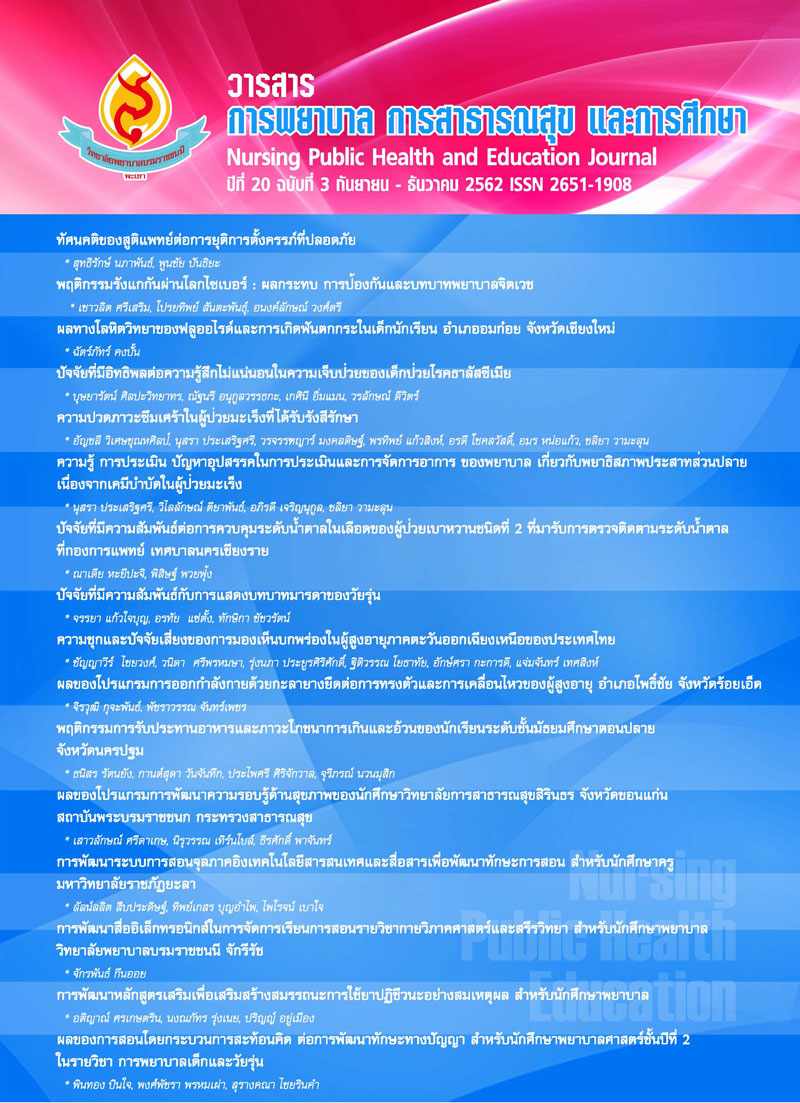ความปวดภาวะซึมเศร้าในผู้ป่วยมะเร็งที่ได้รับรังสีรักษา
Keywords:
ความปวด, ปวดเหตุพยาธิสภาพ, รังสีรักษา, มะเร็ง, ภาวะซึมเศร้า, Pain, Neuropathic pain, Radiotherapy, Cancer, DepressionAbstract
ความปวดภาวะซึมเศร้าเป็นปัญหาที่พบบ่อยในผู้ป่วยมะเร็งยังมีข้อมูลจำกัดในการศึกษาความปวด และ ภาวะซึมเศร้าในผู้ป่วยมะเร็งที่ได้รับรังสีรักษาการศึกษานี้มีวัตถุประสงค์เพื่อศึกษาความปวดและภาวะซึมเศร้าของผู้ป่วยมะเร็งที่ได้รับรังสีรักษา การวิจัยครั้งนี้เป็นวิจัยเชิงพรรณนาแบบตัดขวาง กลุ่มตัวอย่างเป็นผู้ป่วยมะเร็งที่ได้รับรังสีรักษา โรงพยาบาลมะเร็งอุบลราชธานี จำนวน 166 คน เก็บข้อมูลด้วยแบบบันทึก cancer profile แบบสอบถามความปวด Brief Pain Inventory (BPI) แบบประเมินDN4 ประเมินลักษณะความปวดNeuropathic และแบบประเมินภาวะซึมเศร้าThe Center for Epidemiological Studies Depression Scale (CES-D) วิเคราะห์ข้อมูลเชิงปริมาณโดยใช้สถิติเชิงพรรณนา ได้แก่ ความถี่ ร้อยละ ค่าเฉลี่ย และส่วนเบี่ยงเบนมาตรฐาน ผลการวิจัยพบว่ากลุ่มตัวอย่างเป็นผู้ป่วยมะเร็งเต้านมมากที่สุด ร้อยละ 16.9 ส่วนใหญ่อยู่ในระยะที่ 2 มีความปวด ร้อยละ 47.6 และ ลักษณะความปวดแสบปวดร้อน มากที่สุดร้อยละ 33.1 ความรุนแรงของความปวดมากที่สุดเฉลี่ย 3.47 (SD3.40) ปวดน้อยที่สุดเฉลี่ย 1.52 (SD1.85) ความรุนแรงความปวดระดับเล็กน้อยถึงปานกลาง ความปวดรบกวนในชีวิตประจำวันที่มากที่สุด ได้แก่ ด้านการนอนหลับเฉลี่ยเท่ากับ 2.95 (SD ± 3.49) พบกลุ่มตัวอย่างที่ได้รับรังสีรักษามีภาวะซึมเศร้า ร้อยละ 13.3
Pain and Depression in Cancer Patients Receiving Radiotherapy
Pain and depression are a common problem in cancer patients. There has been limited information on the study of pain and depression in cancer patients receiving radiotherapy. This study aimed to study pain and depression of cancer patients receiving radiotherapy. The cross-sectional descriptive design was conducted. The samples were 166 cancer patients who were received radiotherapy in UbonRatchathani Cancer Hospital. Data were collected using cancer profile, the Brief Pain Inventory (BPI), the DN4 questionnaire was used to identify neuropathic characteristics,and the Center for Epidemiological Studies Depression Scale (CES-D). Data were analyzed by using descriptive statistics.The results found that the samples were the most breast cancer patients (16.9%) and the most was stage 2. Pain was report 47.6 %,pain with neuropathic characteristics was reported (33.1%). The mean of worst pain intensity was 3.4 (SD±1.6), mean of least pain was 1.52 (SD±1.85). The most disturbing pain in daily life was sleeping, the mean was 2.95 (SD ± 3.49).The sample with depression was 13.3%.
References
Blanchard, D., Bollet, M., Dreyer, C., Binczak, M., Calmels, P., Couturaud, C., . . . Moriniere, S. (2014). Management of somatic pain induced by head and neck cancer treatment: pain following radiation therapy and chemotherapy. Guidelines of the French Otorhinolaryngology Head and Neck Surgery Society (SFORL). Eur Ann Otorhinolaryngol Head Neck Dis, 131(4), 253-256. doi: 10.1016/j.anorl.2014.07.001 S1879-7296(14)00097-0 [pii]
Bouhassira, D., Luporsi, E., & Krakowski, I. (2017). Prevalence and incidence of chronic pain with or without neuropathic characteristics in patients with cancer. Pain, 158(6), 1118-1125.
Chaudakshetrin, P. (2009). Validation of the Thai Version of Brief Pain Inventory (BPI-T) in cancer patients.
Davis, M. P. (2018). Cancer-related neuropathic pain: review and selective topics. Hematology/Oncology Clinics, 32(3), 417-431.
Dong, S. T., Butow, P. N., Costa, D. S., Lovell, M. R., & Agar, M. (2014). Symptom clusters in patients with advanced cancer: a systematic review of observational studies. Journal of pain and symptom management, 48(3), 411-450.
Donsuk Pongnikorn, Krittika Suwanrungruang, & Rangsiya Buasom. (2015). Cancer Incidence in Thailand. Cancer in Thailand, 9(2013-2015).
Gröpper, S., van der Meer, E., Landes, T., Bucher, H., Stickel, A., & Goerling, U. (2016). Assessing cancer-related distress in cancer patients and caregivers receiving outpatient psycho-oncological counseling. Supportive Care in Cancer, 24(5), 2351-2357.
Hess, C. B., & Chen, A. M. (2014). Measuring psychosocial functioning in the radiation oncology clinic: a systematic review. Psycho‐Oncology, 23(8), 841-854.
Kataoka, T., Kiyota, N., Shimada, T., Funakoshi, Y., Chayahara, N., Toyoda, M., . . . Minami, H. (2016). Randomized trial of standard pain control with or without gabapentin for pain related to radiation-induced mucositis in head and neck cancer. Auris Nasus Larynx, 43(6), 677-684. doi: 10.1016/j.anl.2016.02.012 S0385-8146(16)30067-0 [pii]
Lewis, S., Salins, N., Kadam, A., & Rao, R. (2013). Distress screening using distress thermometer in head and neck cancer patients undergoing radiotherapy and evaluation of causal factors predicting occurrence of distress. Indian journal of palliative care, 19(2), 88.
Linden, W., Vodermaier, A., MacKenzie, R., & Greig, D. (2012). Anxiety and depression after cancer diagnosis: prevalence rates by cancer type, gender, and age. Journal of affective disorders, 141(2-3), 343-351.
Massie, M. J., Lloyd-Williams, M., Irving, G., & Miller, K. (2011). The prevalence of depression in people with cancer. Depression and Cancer. Oxford: Willey-Blackwell, 1-36.
Radloff, L. S. (1977). The CES-D scale: A self-report depression scale for research in the general population. Applied psychological measurement, 1(3), 385-401.
Schaller, A., Dragioti, E., Liedberg, G. M., & Larsson, B. (2017). Quality of life during early radiotherapy in patients with head and neck cancer and pain. J Pain Res, 10, 1697-1704. doi: 10.2147/JPR.S138113 jpr-10-1697 [pii]
Schaller, A., Dragioti, E., Liedberg, G. M., & Larsson, B. (2017). Quality of life during early radiotherapy in patients with head and neck cancer and pain. Journal of pain research, 10, 1697.
Siegel, R. L., Miller, K. D., & Jemal, A. (2017). Cancer statistics, 2017. CA: a cancer journal for clinicians, 67(1), 7-30.
Valli, M., Cima, S., Fanti, P., Muoio, B., Vanetti, A., Azinwi, C. N., . . . Richetti, A. (2018). The role of radiotherapy in elderly women with early-stage breast cancer treated with breast conserving surgery. Tumori, 300891618792465. doi: 10.1177/0300891618792465
Van Den Beuken-Van, M. H., Hochstenbach, L. M., Joosten, E. A., Tjan-Heijnen, V. C., & Janssen, D. J. (2016). Update on prevalence of pain in patients with cancer: systematic review and meta-analysis. Journal of pain and symptom management, 51(6), 1070-1090. e1079.
Wang, X., Zheng, B., Lu, X., Bai, R., Feng, L., Wang, Q., . . . He, S. (2018). Preoperative short-course radiotherapy and long-course radiochemotherapy for locally advanced rectal cancer: Meta-analysis with trial sequential analysis of long-term survival data. PLoS One, 13(7), e0200142. doi: 10.1371/journal.pone.0200142 PONE-D-18-00044 [pii]
Zhang, W. W., Wu, S. G., Sun, J. Y., Li, F. Y., & He, Z. Y. (2018). Long-term survival effect of the interval between mastectomy and radiotherapy in locally advanced breast cancer. Cancer Manag Res, 10, 2047-2054. doi: 10.2147/CMAR.S163863 cmar-10-2047 [pii]


